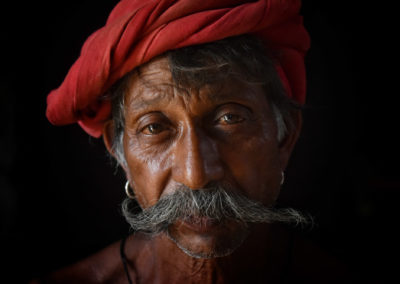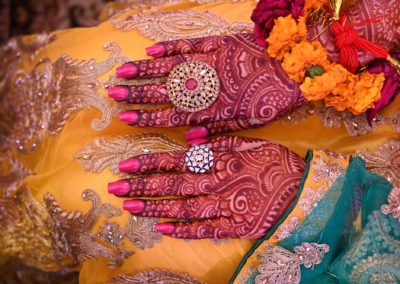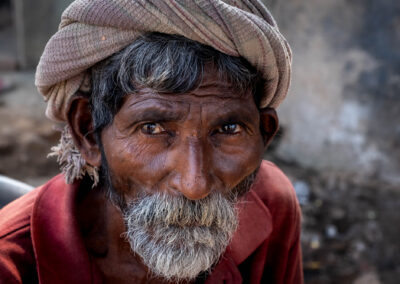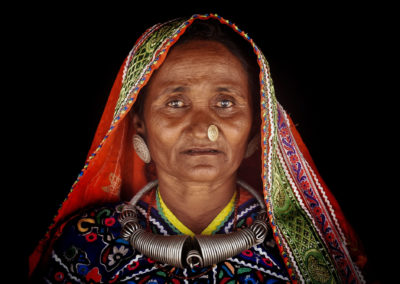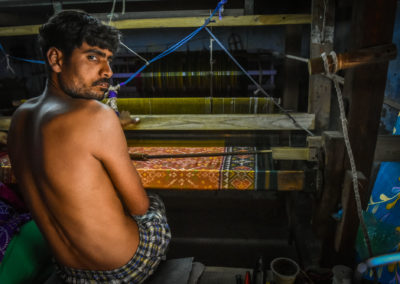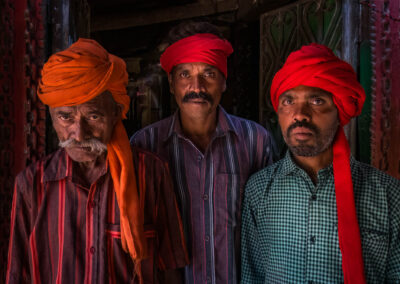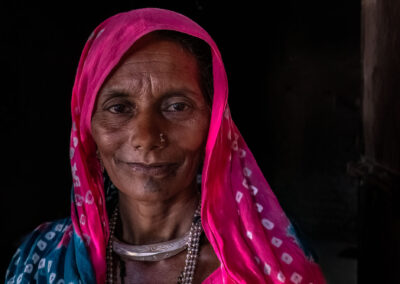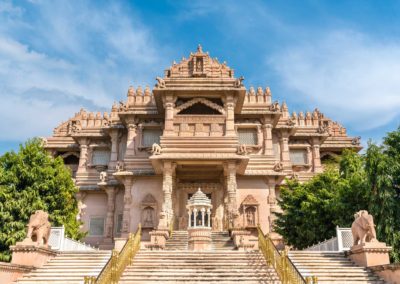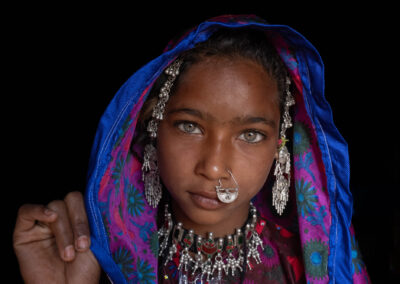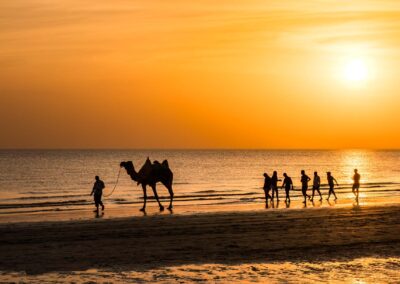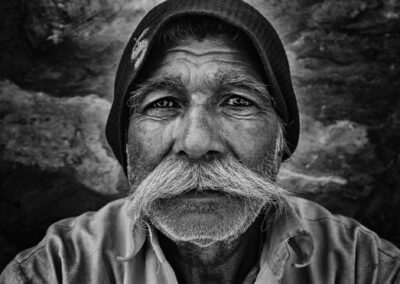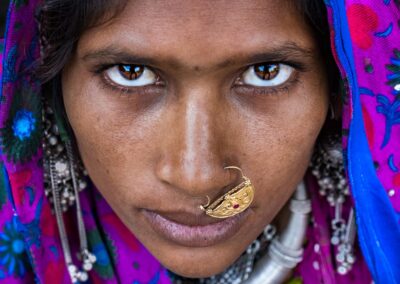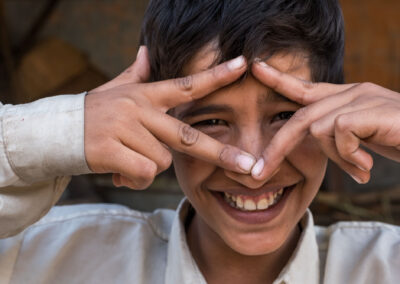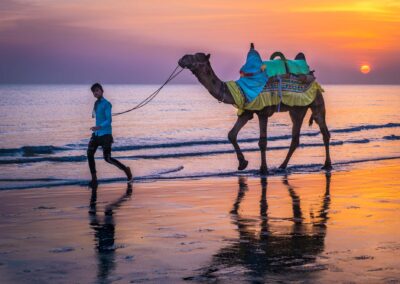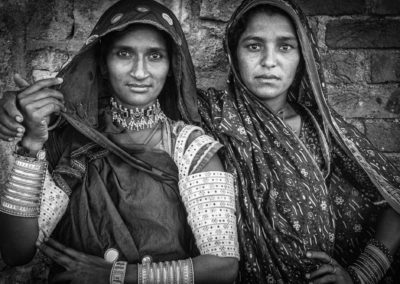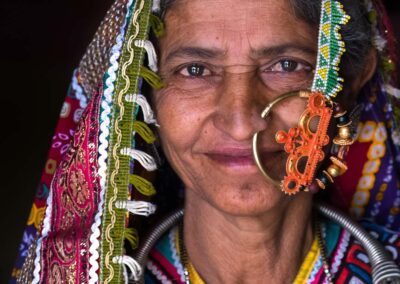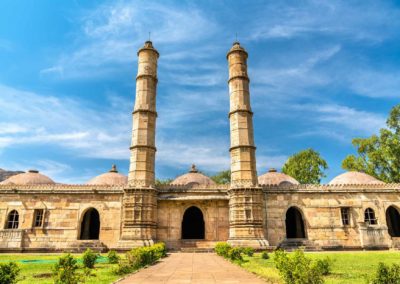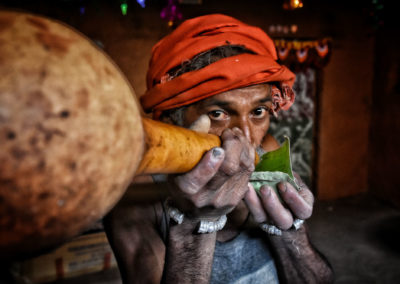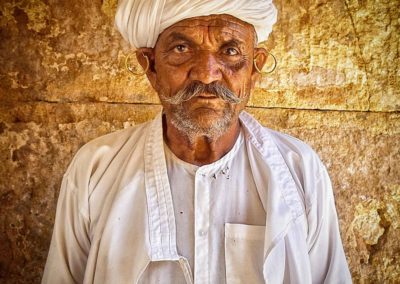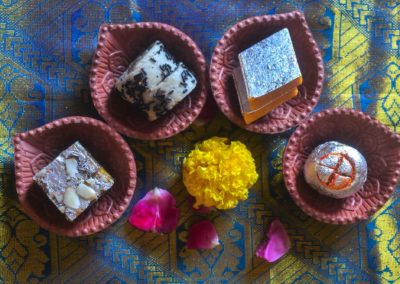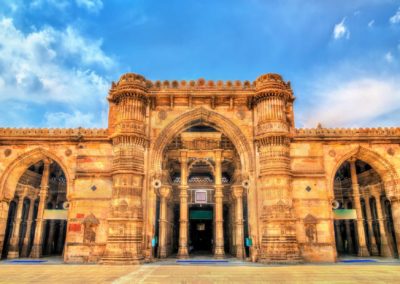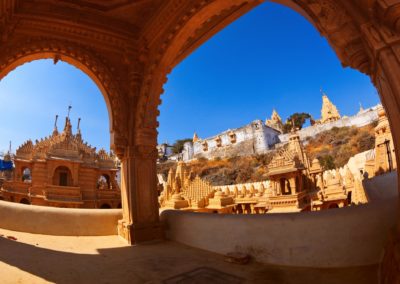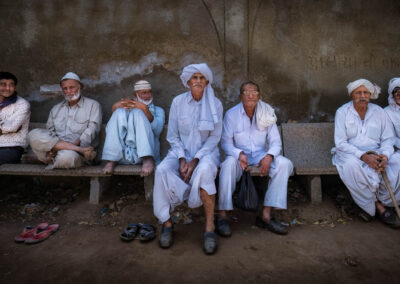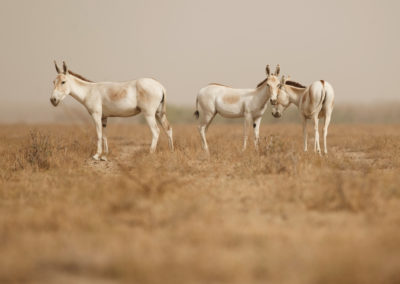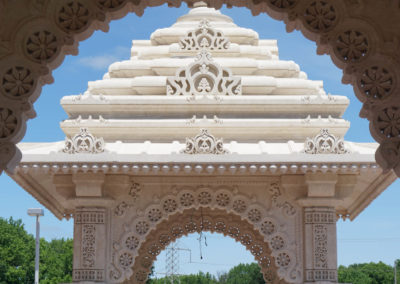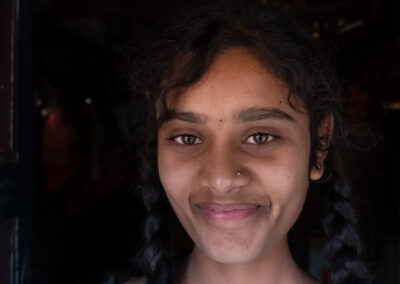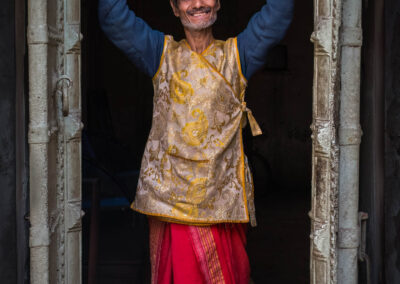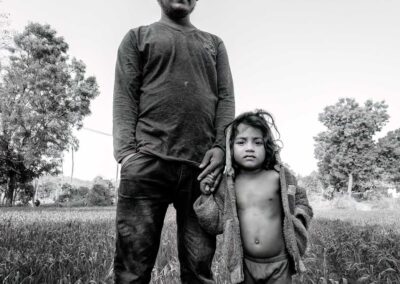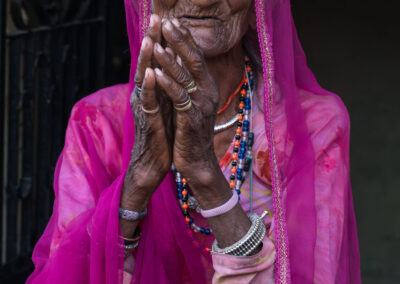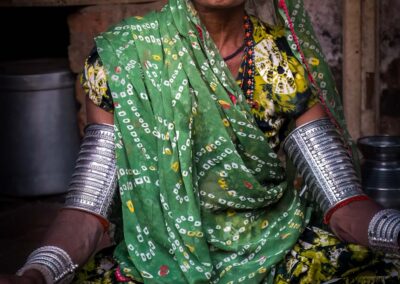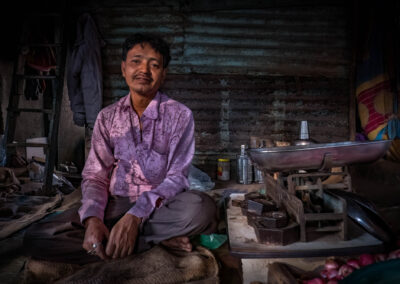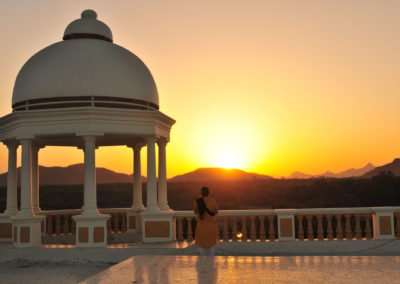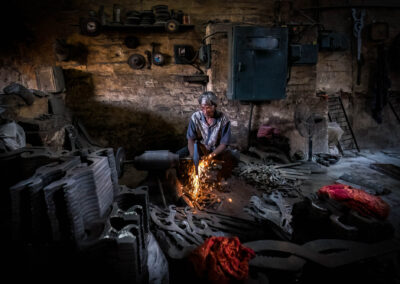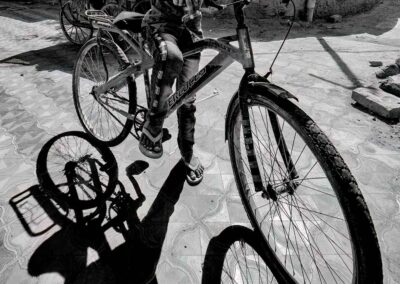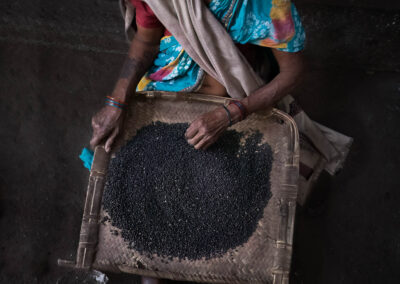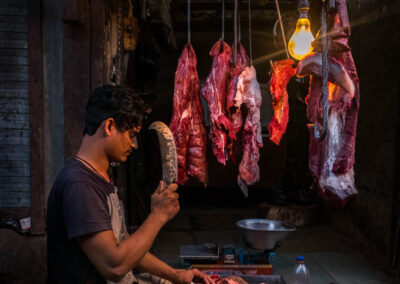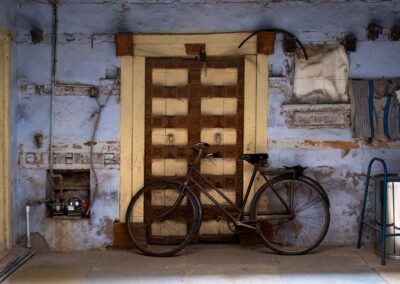
Portrait, Cultural and
Landscape Photography
March 1-13, 2025
• 13 or 16 Days
• Only 4-7 Guests
• Photographer | Guide
• 3, 4 & 5-Star Hotels
• Breakfasts + 8 meals
• Local Guides
• Local Transportation
• 2 Domestic Flights
THE LOST TRIBES OF GUJARAT
Delhi, Ahmedabad, Jambughoda, Dasada, Bhuj and more
RAJASTHAN
VARANASI
GUJARAT
STREETS OF INDIA
HOLI
KERALA
There is a popular saying in India… “India lives in its Villages”
This 13-day India Photo Tour and Cultural Adventure will unveil the Gujarat region’s rural tribes, vanishing cultures, and closed communities that have withstood the test of time. Along the length and breadth of this West Indian state, a world beyond the ordinary unfolds, where over five million tribal members have crafted their homes and unique lifestyles. This photo trip will leave you with a visual travel diary that records the dozens of people you encounter from every contour of India’s complex social framework.
Before venturing into Gujarat’s rural landscapes, we will begin in Delhi, dropping ourselves into one of its biggest slums, Anand Parbat. Here, we will interact with the Kathputli colony, an artist hub of thousands of dancers, artists, storytellers, and singers whose street performances have brought color and magic into the slum’s ramshackle alleyways. Point your lens at this urban three-ring circus of fire-eating, puppetry, costumes, and makeup.
It is said that “India lives in its villages” and this is what we will discover as we travel through Gujarat. In Jambughoda, we will attend a private tour, intimate dinner, and photoshoot with the royal family of this former principality’s palace. However, in stark contrast, the main part of our trip will consist of encountering and photographing the numerous tribes and communities dotted around Gujarat.
Against the blinding white backdrop of the Kutch district’s arid salt flats, we will capture the Agariya community of farmers, whose weathered faces and salt-crusted hands result from the labor that sustains them. The Jat, Mir, and Rabari tribes will also become our photographic subjects. Our cameras will zoom in on their oversized facial piercings, the intricate embroidery and beadwork of their clothing, and the secret symbols tattooed onto their bodies. We may even catch a glimpse of the transgender and intersex members of the Hijra community. Beyond the bright colors of their clothing and celebratory music-making, their faces tell stories of living life on the shunned fringes of Indian hierarchical society.
Added Bonus: After Gujarat, you can register for a 3-day / 2-night Mumbai extension where you’ll be focusing on the famous Dharavi Slum (from the movie Slumdog Millionaire), Dadar Flower Market, Dhobi Ghat (the world’s largest open-air laundromat), and the Chhatrapati Shivaji Terminus.
This 13-day photography tour is more than just a quest to capture exceptional images; it’s an invitation to elevate your craft and see the world through a new lens. Our expert photographer guides will not only lead you to the most photogenic locations under the best light but help you master the art of visual storytelling. Along the way, you’ll refine your camera techniques and discover how to navigate the challenges of photographing in a foreign land. You’ll also learn to anticipate a scene before capturing the decisive moment, elevating ordinary photos into extraordinary works of art.
Join us for spirited discussions, enriching camaraderie, and moments of unforgettable inspiration. From rural townsfolk to royalty and from artisans to urban acrobats, experiencing Gujarat’s diversity is a once-in-a-lifetime trip. Your visual expedition starts here!
It is said that “India lives in its villages” and this is what we will discover as we travel through Gujarat. In Jambughoda, we will attend a private tour, intimate dinner, and photoshoot with the royal family of this former principality’s palace. However, in stark contrast, the main part of our trip will consist of encountering and photographing the numerous tribes and communities dotted around Gujarat.
Against the blinding white backdrop of the Kutch district’s arid salt flats, we will capture the Agariya community of farmers, whose weathered faces and salt-crusted hands result from the labor that sustains them. The Jat, Mir, and Rabari tribes will also become our photographic subjects. Our cameras will zoom in on their oversized facial piercings, the intricate embroidery and beadwork of their clothing, and the secret symbols tattooed onto their bodies. We may even catch a glimpse of the transgender and intersex members of the Hijra community. Beyond the bright colors of their clothing and celebratory music-making, their faces tell stories of living life on the shunned fringes of Indian hierarchical society.
Added Bonus: After Gujarat, you can register for a 3-day / 2-night Mumbai extension where you’ll be focusing on the famous Dharavi Slum (from the movie Slumdog Millionaire), Dadar Flower Market, Dhobi Ghat (the world’s largest open-air laundromat), and the Chhatrapati Shivaji Terminus.
This 13-day photography tour is more than just a quest to capture exceptional images; it’s an invitation to elevate your craft and see the world through a new lens. Our expert photographer guides will not only lead you to the most photogenic locations under the best light but help you master the art of visual storytelling. Along the way, you’ll refine your camera techniques and discover how to navigate the challenges of photographing in a foreign land. You’ll also learn to anticipate a scene before capturing the decisive moment, elevating ordinary photos into extraordinary works of art.
Join us for spirited discussions, enriching camaraderie, and moments of unforgettable inspiration. From rural townsfolk to royalty and from artisans to urban acrobats, experiencing Gujarat’s diversity is a once-in-a-lifetime trip. Your visual expedition starts here!
Group Size
4-8 Guests
Experience | Difficulty
- Beginner, amateur, enthusiast, and semi-pro photographers
- All cameras and camera phones are welcome
- Moderate schedule
- Travel by private air-conditioned car, train, and minivan
- Minimal elevation changes and lots of walking
- (non-photographers are also welcome)
Weather | Sun
March – Temps 87/58 F 31/15 C Sunrise 7:16 | Sunset 6:32 (18:32)
Includes
- 13 or 16 Days
- Travel, street, people, portrait, cultural, and landscape photography
- Professional photographer | guide
- Photo walks & discussions
- Small group size (4-7 guests)
- 3, 4 & 5-star hotels
- Breakfasts + 8 meals
- Local guides in every city
- 2 Domestic flights
- Airport transfers
- All entrance fees
- Local transportation
Travel Information
Arrival Airport: Indira Gandhi International Airport, Delhi, India (DEL) – Transfer time 50min
Arrival & Departure Airports: Mumbai, India (BOM) or Delhi, India (DEL)
Our adventure begins at 11 AM on the first day and ends at noon on the last day.
Travel Visa: A visa may be required depending on your nationality. Go to Visa Map to find out.
Accommodations
Delhi – The Imperial or similar
Ahmedabad – Hyatt Regency or similar
Jambughoda – Jambughoda Palace or similar
Dasada – Run Rider or similar
Bhuj – Regenta Resort or similar
Mumbai – Taj Lands End, The Westin Mumbai Garden City, or similar
Optional Airport Hotels – JW Marriott Mumbai Sahar (Mumbai) or JW Marriott Hotel (New Delhi)
Helpful Links
> The Imperial Hotel New Delhi – by Michael Chinnici
> Suryagarh Jaisalmer – by Michael Chinnici
> 6 Amazing India Photo Adventures – by Michael Chinnici
Lost Tribes of Gujarat Prices & Dates
Gujarat & Mumbai Prices & Dates
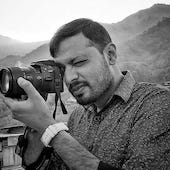
Photographer Leader
PRIYANK TYAGI
March 1-13/15, 2025
*All prices are per person and based on double occupancy. Please select single occupancy for a private room. For your convenience, we offer optional early arrival and late departure accommodations so you can extend your stay before or after the trip. We typically stay in upscale boutique hotels in the 4 and 5-star category. Not all destinations offer these types of properties. We look for unique hotels that offer cultural, historic, and/or authentic features. Depending on the size of the group, smaller boutique hotels may have limited room inventory. In some countries or in remote locations, we may be limited to lodges or branded chain hotels. In Cuba, we stay in upscale family-owned Casas (bread & breakfasts). On all of our tours, breakfast is almost always included, but not guaranteed. Meal categories listed include (B) for breakfast, (L) for lunch, and (D) for dinner.
UPCOMING WORKSHOPS
LOST TRIBES OF GUJARAT 13 DAYS
Day 1 | Delhi
Upon meeting at our hotel in Delhi, we will enjoy group introductions and discuss the days ahead. We will discuss our individual photographic styles, preferred subjects, techniques and level of experience. We will talk about what to expect over the coming days, and how to achieve our photographic goals.
In the evening we will celebrate with a “Welcome Dinner” at one of our favorite Indian restaurants in Delhi. (D)
Day 2 | Delhi - Kathputli Colony - Anand Parbat
We begin with an early morning sunrise shoot on Delhi’s Yamuna River where migrating birds stop to rest. This unique opportunity is not to be missed. We depart the banks of the river using wooden row boats and men trained to attract the birds to our boats. We’ll photograph through the sunrise before returning to our hotel for breakfast.
We will then spend a full day focusing on street, people and portrait photography in the Kathputli Colony. “Kathputli” literally translates into “Puppet”. A colony, which inspired Salman Rushdie’s award winning book, “Midnight’s Children”. This artists colony houses close to 3500 families including acrobats, magicians, puppeteers, storytellers, folksingers, painters, dancers and musicians. They are active artists who have been keeping the streets of Delhi alive with their performing art for over five decades. The colony is located in one of Delhi’s biggest and oldest slums, called “Anand Parbat”. These performers come from 14 states including Gujarat, Maharashtra, Rajasthan and Andhra Pradesh, They belong to diverse communities such as Adivasis, Muslims, Yadavs, Balmikis, Kushths, Nats and Bagris, among others.
These artists are ambassadors of Indian culture who perform at international events, and accompany Indian diplomats and bureaucrats overseas. Aziz Khan, whose rope trick made it into the Guinness Book of World Record in 1995, referred to his art as “their lifestyle and their identity”. Kathputli Colony is trying to hold on to these disappearing symbols of Indian culture and heritage that once adorned the courtyards of the Royals.
We will get “up, close and personal” with various artists, photographing them as they are performing in their home environment. We will walk the narrow lanes of the colony looking for amazing opportunities in this artist’s hub, including their humble homes. As is often the case in India, expect an army of curious and adorable children to follow us everywhere, begging us to take their photos, which will no doubt lead to amazing one-of-a-kind opportunities. (B)
Day 3 | Delhi - Ahmedabad - Adalaj Stepwell
After breakfast we will check out and depart for our flight to Ahmedabad. After check-in, we have a late afternoon/evening photoshoot at Adalaj Stepwell, a five story stepwell on the outskirts of Ahmedabad. Perhaps the finest stepwell in Gujarat, Adalaj was built in 1555. What makes this stepwell one of the most beautiful amongst others is its series of platforms and galleries built into the sides of the stepwell. It is a spectacular example of Indo-Islamic architecture and design. The harmonious play of intricate Islamic floral patterns seamlessly fusing into Hindu and Jain symbolism embody the culture and ethos of those times.
The beautiful interplay of light and shadow on the intricate carvings, arches, and ornamentation will lend itself to capturing very interesting shots of this medieval monument. There is an opening in the ceilings above the landing, which allows the light and air to enter the octagonal well. However, direct sunlight does not touch the flight of steps or landings except for a brief period during the day. If we are lucky we will be able to capture beams of sunlight playing hide and seek on the walls, thus creating a mélange of shadows and light patterns, allowing us to capture this historic monument in “pure” artistic form. (B) (L)
Day 4 | Ahmedabad - Pols - Dada Hari Vav Stepwell - Manek Chowk
The old city of Ahmedabad is one of the best-preserved 14th century living cities of India. After breakfast, we will begin our heritage photo walk of the old city beginning with the Swami Narayan Temple and finishing at the Manik Chowk Book Market. Be prepared for a complete sensory and photography overload. This 600 years old city has some of the finest Indian-Islamic monuments and exquisite Hindu and Jain temples. Its carved wooden houses are unique architectural gems. This heritage city’s varied architecture, its art, religious places, its culture and traditions are a true testimony of secular India’s tolerance and embracing of diverse cultures.
Ahmedabad is comprised of numerous “Pols”, self-contained neighborhoods, sheltering large numbers of people. Some of these Pols are virtually small villages, traversed by narrow lanes, usually terminating in squares (Chowks) comprising “community wells” and “chabutro” (for feeding birds). They are (were) protected by gates, cul-de-sacs and secret passages.
After lunch we will visit the stunning Dada Hari Vav Stepwell. This 15th century iconic step-well was built during the reign of Mehmud Begda. The design is simply breathtaking giving us an amazing opportunity to photograph the elaborate, intricate carvings on its walls, which was the hallmark of medieval Gujarati architecture. This iconic, must do monument, will also provide us with shots of local people visiting the well. Another very interesting photography opportunity, which invariably presents itself in most stepwells in India, are the young couples out on dates.
In the evening we will focus on Manek Chowk, a prominent vegetable market during the wee hours of the morning, transforms itself into a bustling jewelry hub as the day progresses. However, it is in the night when this area truly comes alive and transforms itself into a street food hub. A great place to sample the delicious, finger licking street food. Yes, we will sample what is on offer and walk around to capture the busy, bustling street food vendors and local people enjoying an evening out with their families and friends. We will encounter several interesting characters plying their trade here and practice photographing in neon light. (B)
Day 5 | Ahmedabad - Jambughoda - Jambughoda Palace
Today we depart Ahmedabad for Jambughoda. Really off the beaten path, Jambughoda used to be the erstwhile principality in its heyday. The Royal Family is a descendant of the Parmar Dynasty from Dhar in Madhya Pradesh. Their ancestors ruled the state until its merger with the Indian Union in 1948 for the greater good of its people and India. HH Maharana Vikramsinhji resides at the Palace with his family in this quaint palace. On one end of the property is the 200-year-old palace, where Vikramsinhji’s family lives. One wing has been converted to accommodate guests; the former royal kitchens, stables, and staff quarters have also been refurbished as suites and rooms. The decor is old-world, with the Jambughoda crest emblazoned above each door. Intricate latticework and carvings blend to create Champaner’s Indo-Saracenic architectural style. We’ll be staying at this heritage hotel, the Jambughoda Palace.
The Jambughoda Wildlife Sanctuary is a 20-minute drive from the palace. The area was declared a sanctuary in 1990. Vikramsinhji is now on a mission to ensure that the two-lane highway here is not converted into four lanes, as this would displace several villages and the many leopards, panthers, four-horned antelope, and over a hundred species of birds that reside in this area.
After we check-in we will set out to photograph the farming community who live in the villages near the palace. Their ancestors migrated to Jambughoda from Dhar region in Madhya Pradesh several centuries ago.
Living a simple, traditional pastoral lifestyle, we will photograph them going about their daily lives. There will be ample opportunities to venture into their homes and capture a rural lifestyle, which revolves around traditional farming practices that they are engaged in for generations.
PWA Exclusive: We will get to photograph the members of the royal family in the backdrop of their royal heritage and memorabilia, in the private spaces of the palace. The current owner Vikramsinhji will personally escort us around his home and tell us stories about his illustrious ancestors whose photographs line the ground floor of the house. Additionally, we will able to photograph the royal family in their traditional attire, which lends itself beautifully to close up compositions, portraiture.
Afterward, Vikramsinhji and his son will join us for dinner. Regaling us with tales from his childhood at the prestigious Doon School. A warm and gregarious person, his commitment and passion to Jambughoda, his guests are quite evident. Guests will get insider access to stories, tales of a bygone era of princely India, straight from the Indian Maharaja! (B) (D)
Day 6 | Jambughoda - Rathwas and Nayak Tribes
Today we will focus on photographing the distinct culture of the Rathwas and Nayak Tribes. Our aim will be to photograph men, women and children in their traditional attire at the weekly village markets called “HAAT”. These weekly markets are a hub of activity and a great opportunity to photograph numerous tribes in one location, while they are shopping, selling local produce and various household items. After we will photograph them in their homes in the adjoining villages of Rangpur, Gunata and Surkeda.
The traditional dress of the adult males are langoti (loin cloth), kachuta and the phenta (headgear). The females dress in ghagaro (lower garment) and cholia (upper garment). The women wear kala (armlet) made up of chandi (silver) but kala, (armlet) of men is of iron. They also wear fasi at the wrist, which is made up of silver, biti (finger rings), and have tattoo marks on their body. (B) (L)
Day 7 | Jambughoda - Rathwas and Nayak Tribes
We will continue photographing the unique cultural and traditional lifestyle of the Rathwas and Nayak tribes in the Chhota Udaipur region. We will have an opportunity to visit the village home of these tribes and photograph the tribal women going about their daily lives which include cooking, daily chores, and taking care of her children. (B)
Day 8 | Jambughoda - Dasada - Rabaris, Jat, Mir and Agariya Tribes
After breakfast we depart for Dasada, a five hour drive from Jambughoda. Dasada is located on the edge of little Rann of Kutch, which is an extension of the Rann of Kutch onto Saurashtra. The tribal heritage of the area is truly unique and is home to several ethnic communities. Some of the tribal communities, which inhabit this desolate landscape, are the Rabaris, Jat, Mir and Agariya. The tribal women are skilled in traditional crafts, specifically in embroideries and silk weaving techniques. The surrounding regions of this destination have some of the most incredible ancient monuments, temples and heritage sites.
One of the most visually striking tribes of Gujarat is the Mir. Post check in we will get to photograph the Mir tribal women in the nearby villages, and in small rural encampments. The women wear heavy silver necklaces and other adornments. Their outfits are known for their detailed intricate embroidery and are brilliantly colored. As a symbol of their marital status they wear hard plastic bracelets, and are extremely outgoing in nature. In the evening we will settle in for dinner and a post processing editing session. (B)
Day 9 | Dasada - Sun Temple - Hindu Pilgrims - Agariya
Today our focus will be on photographing the incredibly beautiful temples in the region. One hour’s drive from the main town is the Modhera Sun Temple. Built in 1926, it is known as, “Poetry in Stone”. From there we will proceed to the Bahucharaji Temple, which is 20 minutes away. This Hindu Temple is dedicated to the Goddess Bahucharaji and worshipped by all of the Hindu faith. Additionally, we will be encountering many Hindu pilgrims at the temples and will get an opportunity to photograph pious, spiritual moments.
If we are lucky we will attempt to photograph the Hijra community, which consists of cross-dressing men/women (yes you heard correctly). They are considered the third sex and socially ostracized.
The Agariya community is the traditional salt harvesters of the vast white desert criss crossing the Rann of Kutch. We will photograph Agariya men and women harvesting salt in extreme working conditions. These emotive scenes, which you will witness, will translate into a moving essay on depths of human endurance and indomitable will. (B) (L)
Day 10 | Dasada - Bhuj - Kutch - Great Rann and Little Rann
After breakfast we depart Dasada for Bhuj, a five hour drive. We will stop en-route for interesting photo opportunities.
The Kutch district has had four thousand years of inhabitation to build up a long and complex history, especially its capital, Bhuj. The word kutch means “island” in classical Sanskrit, referring to the fact that in antiquity, the Ranns (meaning deserts) of Kutch were submerged by the Indus River flowing into the sea, leaving the area isolated by an immense shallow body of water. In 1819 an earthquake changed the topography and the Indus began to flow further westward, leaving the Ranns (now separated into the Great Rann and Little Rann) as a vast desert of saline flats. During heavy rains, the Ranns still flood, leaving islands, known as beyts, such as Khadir.
Upon independence, Kutch became a state in India, while neighboring Sindh joined Pakistan. This cost Kutch the nearby major port of Karachi, leading to the development of Kandla as an important port for the region. Twice, territorial disputes with Pakistan over parts of Kutch have led to fighting, once just before the Second Kashmir War and once around the time of the Kargil Conflict. Today no border problems exist, and because the actual frontier lies within the Great Rann, it would be extremely difficult for anyone to cross the vast expanse of very harsh desert, but the Indian Army keeps a close watch anyway.
After check-in we will begin exploring and preparing for the next two days of photography in Kutch. (B)
Day 11 | Bhuj - Ahir, Rabari and Meghwal Tribes
Photographing the Ahir, Rabari and Meghwal tribal women in their home environments will be highlight of our day today. We will be visiting the villages of Hodka, Ludia to photograph their traditional lifestyle and unique cultural identity. Women from each of the above tribes adorn themselves with stunning pieces of gold or silver jewelry, brilliantly hued, and wear intricately designed embroidered traditional outfits. Thus giving us a unique and rare opportunity to photograph them in their traditional finery.
The Rabari women wear heavy brass earrings, black full-length shawls; have tattoos of magical symbols on their chests, neck and arms. However, the women are most renowned for their detailed embroidery and beadwork. Rabari women embroider clothing, bags, household decorations and animal trappings in patterns that subtly highlight significant events, rites and values in their lives, as well as historical events important to the entire tribe, which helps to perpetuate knowledge of their heritage, particularly as the majority of them are illiterate and have no written tradition.
Meghwals women are also highly skilled artisans, embroiderers. Some of their stitching and iconography bears a strong resemblance to embroidery done in Afghanistan, and the Hazara and Kandhar regions of Pakistan, suggesting that influences came from the north as well as the east.
In the early evening we will be heading to the vast saltpans of Rann of Kutch to capture the shimmering white moonscape. Photographing this magical landscape in the soft evening light will be a beautiful experience. (B)
Day 12 | Bhuj - Jat & Rabaria Tribes - Mandvi Beach - Boat Builders
Photo Shoot of the Jat & Rabaria tribes. Sunset Photography sessions at Mandvi Beach and Wooden boat building shipyard.
The Jat tribes residing in the Kutch region are by far the most striking in their attire and unusual jewelry that they wear. They are a cattle breeding nomadic Muslim community who have roamed these ancient lands for centuries in search for greener pastures for their herds. We will be visiting the nearby village of Khowda to photograph the women of the tribe in their stunning attire and gorgeous jewelry. The married women in the tribe wear a massive nose ring, which is held, in position by a thick strand of hair. This is done to balance the weight of the nose ring. The streets of Bhuj city will also be another location for photographing these fascinating women. If we are lucky, we may also spot the moving caravans of the Rabari Gypsy Nomads with their entire families, possessions and herd of livestock – goats, camels, and cattle. The old and historic city of Bhuj also has a unique character and charm. We will walk the streets on a lookout for interesting local people and environmental shots.
After lunch we will drive to Mandvi Beach for hopefully a spectacular sunset overlooking the Arabian Sea.
One of the highlights of our Gujarat photo adventure would be to photograph the skilled artisans keeping a 400-year-old wooden boat building tradition alive! Mandvi is the largest wooden boat building port in India. There we will photograph the boat builders, the massive wooden boats under construction. As maritime trade grew, traders—belonging to the seafaring Kharva community of both Hindus and Muslims—developed a new expertise: boat-making and repairing to add to their traditional navigational skills.
They became adept at building their own ships, known as dhows, for use in the thriving cargo trade. Today, this almost 400-year-old tradition and craft still endures, but is slowly on its way out. The dhows are entirely wooden—built of sal wood imported from Malaysia, Indonesia, and Burma, or procured locally from Gujarat’s babool trees. Built by hand by craftsmen who are barely literate and have no training in engineering.
After sunset we will celebrate with a “Farewell Dinner” in Bhuj. (B) (L) (D)
Day 13 | Bhuj - Mumbai - Delhi (optional)
We are up very early for a flight to Mumbai, connecting to Delhi. You may choose to stay in Mumbai, fly out of Mumbai, or connect to Delhi if your return roundtrip is in and out of Delhi. Our guide will be returning to Delhi so you will be escorted. If you select an airport late departure hotel room, please specify what city you will be departing from. (B)
MUMBAI STREETS 3-DAY EXTENSION
Day 1 | Gujarat - Mumbai - Chhatrapati Shivaji Terminus, Gateway of India
Upon arrival in Mumbai, we will checkin to our hotel and relax for some time, before heading to our photo adventure in this amazing city.
Mumbai, formerly Bombay, is the largest city in India, followed by Delhi and Kolkata. It’s full of dreamers and laborers, starlets and gangsters, Bollywood wannabes and the poorest of slums, stray dogs and exotic birds, artists and servants, fishermen and millionaires, and lots and lots of people. Mumbai is India’s financial powerhouse, fashion epicenter, and a pulse point of religious tension.
We will focus on the Chhatrapati Shivaji Maharaj Terminus (Mumbai’s main railway station). Imposing, exuberant, and overflowing with people, this monumental train station is the city’s busiest. We’ll photograph riders passing through on their trains. On the outside, we’ll find the most extravagant Gothic building and an aphorism of colonial-era India. It’s a mix of Victorian, Hindu, and Islamic styles whipped into an imposing Dali-esque structure of buttresses, domes, turrets, spires, and stained glass. (B)
Day 2 | Mumbai - Dharavi Slum - Mumbai Train Station
Today we will focus on the Mumbai Train Station and the Dharavi Slum, and possibly additional neighboring slums (time permitted). Dharavi is considered to be one of world’s largest slums. It has an area just under one square mile and a population of about 700,000. With a population density of over 277,136/km², Dharavi is one of the most densely populated areas in the world. Our morning in Dharavi will be intense and stressful, enlightening and moving, sad and heartwarming.
In the evening we will enjoy yet another “Farewell Dinner”, but this time until we meet again. (B, D)
Day 3 | Mumbai - Departure
After breakfast we will conduct our final review of photos and discussions about the adventure, and bid you farewell.
We urge you to extend your stay in Indian subcontinent and apply all the wonderful photographic techniques you learned on this photo adventure. (B)
(B) Breakfast, (L) Lunch, (D) Dinner, (E) Excursion
May all who come as guests... leave as friends®

OPTIONS AND BENEFITS
Pricing
All prices are per person and based on double occupancy. Please select single occupancy for a private room. For your convenience, we offer optional early arrival and late departure accommodations so you can extend your stay before or after the trip. We typically stay in boutique hotels in the 4-star category. Not all destinations offer these types of properties. We look for unique hotels which offer cultural, historic and/or authentic features. Depending on the size of the group, smaller boutique hotels may have limited room inventory. In some countries or in remote locations, we may be limited to lodges or branded chain hotels. Breakfast is included only if included in our room rates.
Private Guided Adventures
We offer amazing private guided photo adventures, cultural tours and vacations for individuals, couples, families and groups. We can customize any of our published adventures, as well as others, to meet your individual needs, schedule, budget and interests. This may include the finest 5-star accommodations, business-class travel, and private guides and fixers who are able to make the impossible possible. If you are not interested in a photo-centric vacation, but you love our approach to private travel, we will be happy to design and deliver an amazing adventure focused on travel, culture and cuisine. Click here to request a quote. Feel free to call us at 1-888-834-0288 or contact us for more information.
Travel Insurance
We offer travel insurance through the internationally recognized Travelex Travel Insurance Company, as well as evacuation and medical transportation insurance through MedJet, one of the best in the industry.
The cost for travel insurance can be as low as 4% of the total trip cost, depending upon age and other factors. Knowing you have trip cancellation coverage can make a big difference should you have to cancel for some unforeseen reason. Travelex Insurance Services is a BBB Accredited business with an A+ rating. Click here to learn more about why you should consider travel insurance.
Rewards Program
Start earning points today and SAVE $200 - $900 off future trips!
Simply register for one of our amazing photo adventures and begin earning points today!
How The Program Works
For every adventure reservation you make with Photo Workshop Adventures, you earn valuable points which you can redeem on your next trip. This is a great way to save up to 8% off future trips. Our Rewards Program is designed with three tiers: Orange, Gold and VIP Members. Points may be applied towards balance payments on your next trip, or you may choose to accumulate points for a free trip in the future.
ORANGE REWARDS
All guests begin with our Orange Rewards Program (Level 1), which earns 4 points for every dollar you spend. You begin earning points immediately after your first trip. A $5,900 spend earns 23,600 points with a value of $236 USD.
GOLD REWARDS
With our Gold Rewards Program (Level 2), you earn 6 points for every dollar you spend. Orange Members who reach 120,000 accumulated lifetime* points (approx. 4-6 trips), automatically move up to Gold Rewards. A $5,900 spend earns 35,400 points with a value of $354 USD.
Additional Gold Benefits:
- Earn up to double points during promotional events
- Advance notifications for upcoming adventures and special offers
VIP REWARDS
With our VIP Rewards Program (Level 3), you earn 8 points for every dollar you spend. Gold Members who reach 350,000 accumulated lifetime* points (approx. 8-12 trips) move up to VIP Rewards. A $5,900 spend earns 47,200 points with a value of $472 USD, (8+/-% discount).
Additional VIP Benefits:
- Earn up to double points during promotional events
- Advance notifications for upcoming adventures and special offers
- Ability to Gift or Transfer points to others
- Receive complimentary airport transfers at the destination location*
Redeeming Your Points
Redeeming your points couldn’t be easier. You can always log in to your account to check your points balance. When you are ready to book your next trip, register and pay your deposit. When you go to pay your balance you will be given the option to apply your points and receive a discount.
THINK ORANGE Magazine
Subscribe to our Think Orange Magazine and eNews. THINK ORANGE is a wonderful mix of stories and tips related to travel, photography, adventure, culture, art, technology, cuisine, lifestyle, people and more. Our objective is to immerse you in a world you may only fantasize about. Raise your awareness and inspire your creativity. Perhaps even help make you a better photographer. We deliver similar experiential experiences that our guests enjoy on our photo adventures. Like all of our adventures, our blog is “photo-centric”, while also allowing you to experience all the nuances and cultural aspects of travel and adventure. Welcome to our world. We hope you enjoy. Our eNews is a great way to receive information about upcoming photo adventures, exciting new destinations, photography tips, special offers and more. Subscribe today!
Gift Cards
Give someone you know a Gift Card, good toward any of our Photo Adventures, Photo Tours, Private Guided Tours, Online Courses, Prints or Merchandize. Our beautifully personalized eGift Cards and Certificates are delivered to you electronically. They are fully transferable and have a 2 year expiration date. They are available in any amount from $100 to $5000. It makes a great gift for anyone who loves photography, travel or adventure. Order now, or email for more information.
